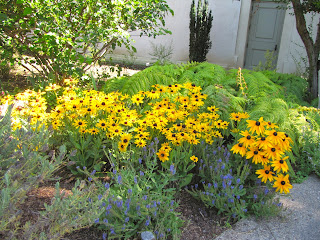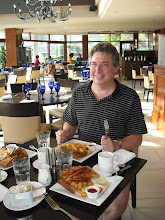San Marino, CA (Greater Los Angeles Area)
August 5, 2012
After doing the Carpenters' tour in Downey, I drove north to San Marino to see where they had shot the video for "Only Yesterday." By the way, on the way to and from San Marino, I passed through Pasadena, Beverly Hills, and other locations that were all potential options for the Carpenters to buy a family house after they became famous. There must have found something about Downey that really appealed to them.
"Only Yesterday" Video: I ran out of time before seeing all of the locations used here.
Being a Sunday, no traffic problems. I expected Huntington Gardens to be a pleasant park with an attractive building housing its library. There is much more there as you can see in this official map.
The entrance... It was $20 for adults.
The North Vista Lawn...
Many beautiful flower beds. On the first one, I had the foresight to photograph its description, which I have added as a caption.
 |
| Eustoma grandiflorum "Laguna Mix" Lisianthus |
Sub-tropical as well...
Also an enormous cactus garden...
Here's the main house.
I liked this covered patio very much. Gave me some ideas for remodeling our house. On a smaller scale you could have screens and removable windows with central fire pit or stove for the winter.
The back side...
The main entrance...
I was told at the front that non-flash photography was OK, but the security guards got upset about the auto-focus laser on my camera. He was actually very reasonable about it, but I had no need to upset anyone and I put the camera away after taking this photo. The Blue Boy is in the far background in the middle.
The Huntington owes its origins to the big railway money and zero income taxes of 19th century California. Henry Huntington had the good fortune to inherit his fair share from his uncle, Collis P. Huntington, who along with Leland Stanford, Mark Hopkins and Charles Crocker were known as the Big Four of the California railway boom. Stanford founded Stanford University, Mark Hopkins is remembered by the famous Nob Hill hotel in San Francisco that bears his name, and Charles Crocker founded the Crocker Bank in San Francisco. Yes, the same Crocker bank that commissioned, "We've Only Just Begun" from Paul Williams and Roger Nichols in 1969. Isn't it cool how that all fits together?
Anyway, back to Henry, not only was he fortunate, he was also prudent: some time after his uncle died, he divorced his first wife and married his widow aunt. Talk about keeping it all in the family! With his wealth assured, Huntington purchased 1000 acres in San Marino where he built a little something worthy of his place in society. After World War I, Europe rolled out the world's largest fire sale on fine art and rare books and Henry collected like no man had collected before him. For example, in the United States, only the Library of Congress has more significant books than the Huntington Library.
Huntington purchased the Blue Boy in 1921 for $740,000, which was, at that time, the largest sum ever paid for a single painting. The transaction was all over the press and the Blue Boy became engrained in the American fabric in the form of legal print copies and paint by numbers sets flooding the market during the mid-20th century. Last year, The Card Players by Paul Cezanne sold for over $250 Million US dollars. It staggers the mind to think what the Blue Boy would sell for if it went to auction today. Fortunately, after Huntington died in 1927, he donated the entire parcel, fortune and collection to the state of California for the public to enjoy, and me, being a solid member of the general public, enjoyed my visit tremendously.
From www.huntington.org/
Jonathan Buttal: The Blue Boy (c 1770)
Thomas Gainsborough (1727-88)
oil on canvas, 70 5/8 x 48 3/4 inches
The best known painting at the Huntington, Gainsborough's The Blue Boy, portrays Jonathan Buttall, the son of a successful hardware merchant, who was a close friend of the artist. The work was executed during Gainsborough's extended stay in Bath before he finally settled in London in 1774.
The artist has dressed the young man in a costume dating from about 140 years before the portrait was painted. This type of costume was familiar through the portraits of the great Flemish painter, Anthony van Dyck (1559-1641), who was resident in England during the early 17th century. Gainsborough greatly admired the work of Van Dyck and seems to have conceived The Blue Boy as an act of homage to that master.
Mr. Huntington purchased the painting along with Gainsborough's The Cottage Door and Reynolds's Sarah Siddons as the Tragic Muse from the Duke of Westminster.
Johann Gutenberg’s Bible was the first substantial book printed with movable type in the West. Printed about 1450-55 in Mainz, Germany, the Bible is in Latin, in the standard medieval Catholic version known as the Vulgate. Only the text, in type called black letter, or gothic, was printed with movable type. The Huntington copy is one of eleven surviving copies printed on vellum, and one of three such copies in the United States. An additional thirty-six copies printed on paper also survive.
The Huntington has the second-largest collection of incunabula in the United States, after the Library of Congress. The term designates books printed before 1501 during the infancy, or “in the cradle,” of the new technology of the printing press.
[David]: the machine printed the text and then an artist went back to hand-illuminate each page. As printing was new, there was no shortage of trained illuminators available. Soon, the craft of hand-illumination became less in demand as printing became a cheap way to distribute entertainment, ideas and innovation thus fueling the Renaissance and the Industrial Revolution. Gutenberg's invention was the Facebook of its day except that the printing press didn't sell your recent vacation story to American Express to be used in a targeted ad on your wall.
Roger Medearis Home in the San Gabriels 1996
David Kelly, Hillside Near Paso Robles 2012
OK, this is not in San Jose, and maybe not as romantic as the painting, but one can see those kinds of folded hills all over this area.
Back to house: nice front deck...
There are also many places to sit down and enjoy the gardens...
And the lawns...
It was actually 90 degrees F, 32 degrees Canadian, so lying on the grass looked like a great idea.
However, I with my ambitious schedule, had to move on. I had planned to visit the Griffith Observatory, LA County Museum of Art and Santa Monica pier before sunset. After doing the Observatory, I observed that it was time for dinner. Went to Fred 62 in the Los Feliz area: looks like a greasy diner, but the food was anything but greasy.

























No comments:
Post a Comment